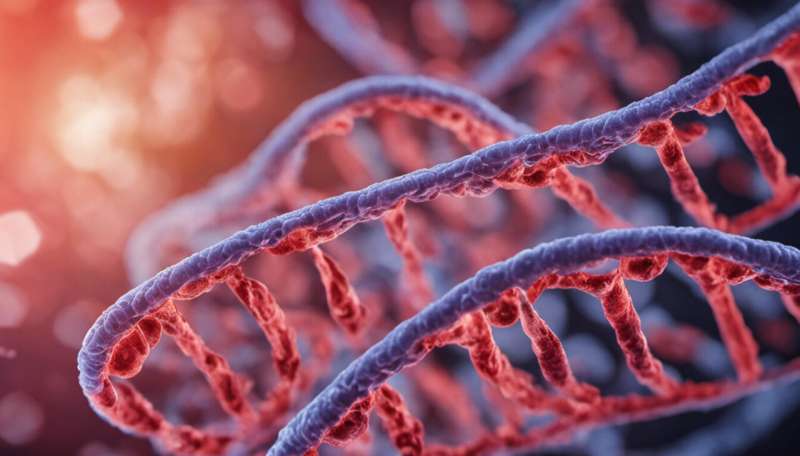This article has been reviewed according to Science X's editorial process and policies. Editors have highlighted the following attributes while ensuring the content's credibility:
fact-checked
peer-reviewed publication
trusted source
proofread
RNA's 'joints' play key role in our gene expression, scientists find

University of Chicago scientists have discovered a new wrinkle in our understanding of how our genes work. The team, led by Chuan He, the UChicago John T. Wilson Distinguished Service Professor of Chemistry, Biochemistry and Molecular Biology, shed light on a longstanding puzzle involved in a common way our genes are modified that is known as RNA methylation.
Published Jan. 27 in Science, the finding could have implications for gene therapies for disease, as well as our picture of gene expression, development, and evolution.
Changing the course
For more than a decade, Chuan He's laboratory has been focused on trying to unravel the puzzle of a phenomenon called RNA methylation, which we are increasingly understanding plays a key role in our bodies and lives—everything from cancer to PTSD to aging.
In the 20th century, we thought that DNA was the blueprint to the cell and everything is faithfully copied and carried out from there. But bit by bit, we began to learn that's not the whole picture. DNA is the base instruction manual, but our bodies respond to our experiences and environment by turning some genes on and off as needed. For example, our skin may respond to sun exposure by producing more melanin that protects the skin; or a plant may change its growth pattern in times of drought to grow shorter and thus require less water.
One way that our bodies do this is a process called RNA methylation—which He's lab has been working to unravel since 2010.
In general, RNA copies DNA and takes the instructions to the cell to make different proteins. But the RNA alters those instructions along the way. One way to turn a particular gene on or off is by attaching a small molecule called a methyl group to the messenger RNA. This change, known as methylation, modifies the instructions that are carried out—changing the course of how your DNA is expressed.
Scientists knew this was important, but they didn't know exactly how the process worked in cells. How does the cell pick which sites to methylate?
"This is an incredibly important process that happens in everything from fish to cows to us—it's how some cells become skin and others become eyes and others become muscles—yet we lacked an understanding of the mechanism itself," said He. "For example, we could see that only a small fraction of the genetic sequence is methylated, but we didn't how these particular sites get chosen."
He's group discovered that cells don't pick certain sites to methylate; rather, they pick where not to methylate. And they think the mechanism lies in the joints of messenger RNA.
After RNA copies the DNA in your cell, it gets sliced up. Some parts of the messenger RNA are cut out, and the remaining parts are glued together and bound by a molecule called an "exon junction complex."
These exon junction molecules, the team found, affect whether or not a particular stretch of messenger RNA can be methylated or not. If the pieces of RNA are short, the two bulky molecules at either end block any methylation from happening. But longer pieces of RNA, with more space between them, are exposed and can be methylated.
The discovery could have major implications for both biology and medicine, the authors explained.
'A significant discovery'
One possible repercussion has to do with artificial genes. As part of gene therapies for cancer and other disorders, as well as for basic research to understand how biology works, scientists will often create stretches of artificial genes and send them into cells. For example, if a patient's tumor is growing out of control, scientists might make an artificial gene that tells it to stop.
But the way scientists have been making these artificial genes so far doesn't include any exon junction complexes in the RNA. Because the exon junction complexes play such a major role in normal gene expression, leaving them out could have effects that scientists hadn't been accounting for.
"When people develop reporters for gene expression or even in gene therapy, there's this additional layer of regulation one needs to consider when designing," said He. "It could be hypermethylated without this packaging, meaning it isn't an exact mimic of the natural process."
The discovery is also a major step forward in our understanding of biology and evolution, He said.
The team observed evidence for this process in everything from zebrafish to humans, but not shellfish or insects. "So vertebrates may have evolved this as a way to tune the stability of their genetic material," he explained.
For example, in humans, brain tissue and heart tissue have very different amounts of exon junction complexes. That means it could play a role in how cells differentiate themselves as they develop from an embryo, He said.
"This discovery suggests a new layer of gene expression regulation and a new pathway to regulate stability of mRNA in general," said He. "We will be working to understand the full implications for a long time."
More information: P. Cody He et al, Exon architecture controls mRNA m 6 A suppression and gene expression, Science (2023). DOI: 10.1126/science.abj9090
Journal information: Science
Provided by University of Chicago


















